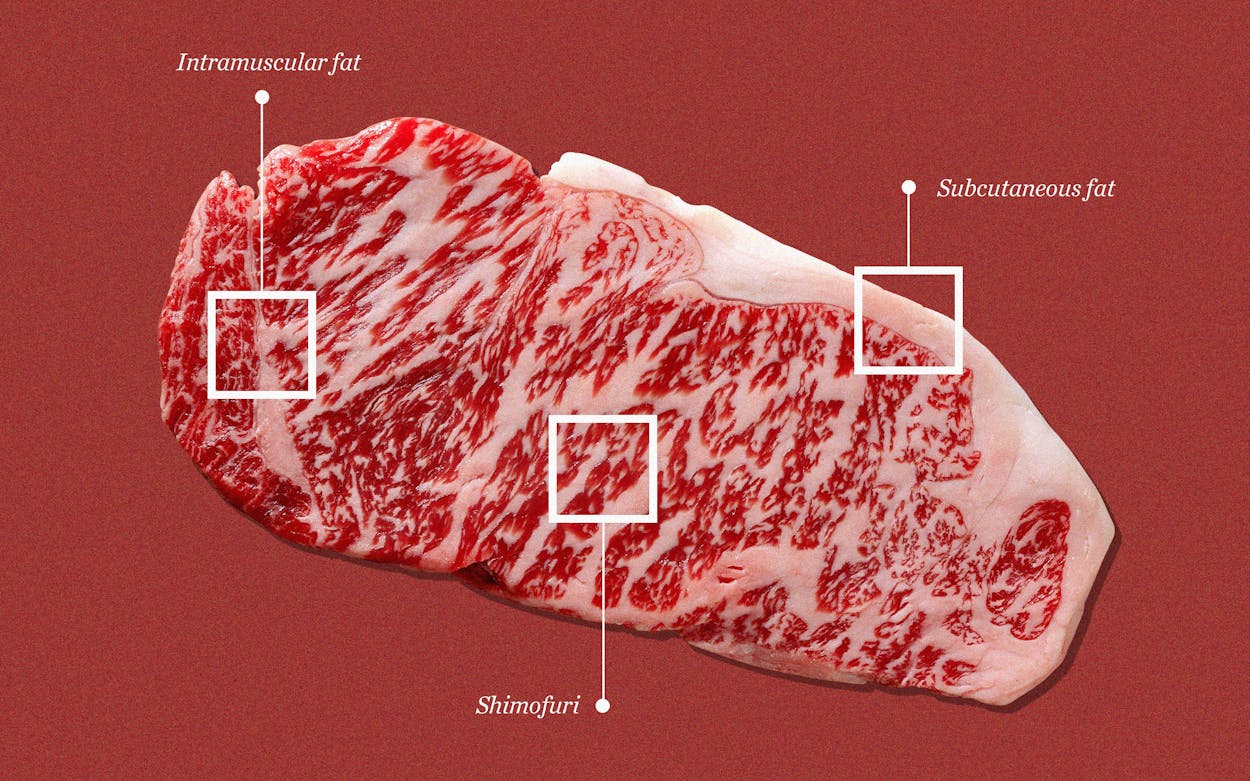You may have heard Wagyu cattle in Japan are massaged daily and bottle-fed beer and fine whiskey by Japanese farmers. Or maybe you’ve heard that the term “American Wagyu” simply means “not Wagyu.” Neither are really true, but the terms used in the Wagyu beef industry can be confusing. It gets worse when they’re translated from Japanese for use by ranchers, consumers, marketers, and government entities in the U.S. This glossary will help clear up some of the myths and redundancies you may have heard about the Wagyu breed.
Wagyu or American Wagyu (United States)
For an animal to be labeled Wagyu, one of the parents must be either purebred or full blood. That means, genetically, the animal being harvested can meet the requirements for being labeled as Wagyu with just 46.875 percent Wagyu bloodlines.
Full blood
Wagyu cattle that are the offspring of a 100 percent Wagyu cow and a 100 percent Wagyu bull, with genetics traced back to Japan. A crossbred animal cannot receive this designation.
Purebred
Wagyu cattle that have at least 93.75 percent or fifteen-sixteenths Wagyu genetics. This percentage is reached by crossbreeding. Purebred was the highest designation possible for Wagyu offspring in America until 1993, when the U.S. imported Wagyu cows.
Percentage
The generic designation for American Wagyu cattle that meet the requirements to be labeled as Wagyu but are neither full blood nor purebred.
F1
The shorthand designation for the offspring off a full-blood or purebred Wagyu and another breed of cattle. The offspring of a full-blood or purebred Wagyu and an F1 is called an F2, and so on until F4, which is considered purebred.
Wangus
The unofficial name for an F1 cross of Wagyu and Angus cattle. Sometimes used as shorthand for American Wagyu because so much of the Wagyu beef raised here is a cross between these two breeds.
Wagyū or 和牛 (Japan)
Cattle native to Japan from one of four distinct breeds: Japanese Black (Kuroge Washu), Japanese Brown (Akage Washu or Akaushi), Japanese Polled (Mukaku Washu), and Japanese Shorthorn (Nihon Tankaku Washu).
Japanese Black (Kuroge Washu)
One of the four distinct Japanese cattle breeds that are considered Wagyu. This is the most prevalent in Japan, and it was first imported to the United States in 1976.
Japanese Brown (Akage Washu or Akaushi)
One of the four distinct Japanese cattle breeds that are considered Wagyu. Often called red Wagyu in the US. This is the second-most prevalent in Japan and was first imported to the United States in 1976.
Japanese Polled (Mukaku Washu)
One of the four distinct Japanese cattle breeds that are considered Wagyu. It is not bred outside of Japan.
Japanese Shorthorn (Nihon Tankaku Washu)
One of the four distinct Japanese cattle breeds that are considered Wagyu. This is the least prevalent and is not found outside of Japan.
Kobe
A term sometimes used erroneously to describe all Wagyu beef. To be considered Kobe beef, the animal must be from the Tajima line of Black Wagyu cattle and raised in the Hyōgo prefecture of Japan. No cattle raised in the U.S. can truly yield Kobe beef.
Mishima
A breed of Japanese cattle that is sometimes marketed as Wagyu but is a distinct breed that is not considered Wagyu in Japan. Only one Mishima bull, Kamui, has been exported to the United States.
Intramuscular fat (IMF)
The flecks of fat within the beef muscle often referred to as marbling. This fat is different than the outer layer of subcutaneous fat.
Subcutaneous fat
The layer of fat between the beef muscle and the hide. This is different from the intramuscular fat. Generally, more subcutaneous fat will be found in animals with a higher yield grade, making the carcasses less valuable.
USDA Beef Quality Grade
The grade given to a beef carcass is based partially on the amount of marbling found in the ribeye between the twelfth and thirteenth ribs. Prime is the highest, followed by Choice and Select grades.
USDA Yield Grade
Measures the amount of subcutaneous fat and other excess fats on a beef carcass. The more fat, the higher the yield grade. Yield grade 1 is the most valuable, and 5 is the least.
A5
This is the best grade beef can receive in the Japanese grading system. The letter designation refers to the yield grade, with A being the best and C being the worst. The number refers in part to the amount of marbling, with the most abundant contributing to a 5 score and the least contributing to a 1. For comparison, beef graded as USDA Prime would be at best a 2 on the Japanese scale. The minimum IMF percentage for the highest tier of Prime beef is 12.22 percent. The lowest IMF percentage for beef to be considered a 5 in the Japanese system is 43.8 percent.
Shimofuri
Japanese word used to describe the abundant marbling in Wayu beef. It translates to a layer of winter frost, or a salt-and-pepper color in English.
- More About:
- The Wild West of Wagyu








